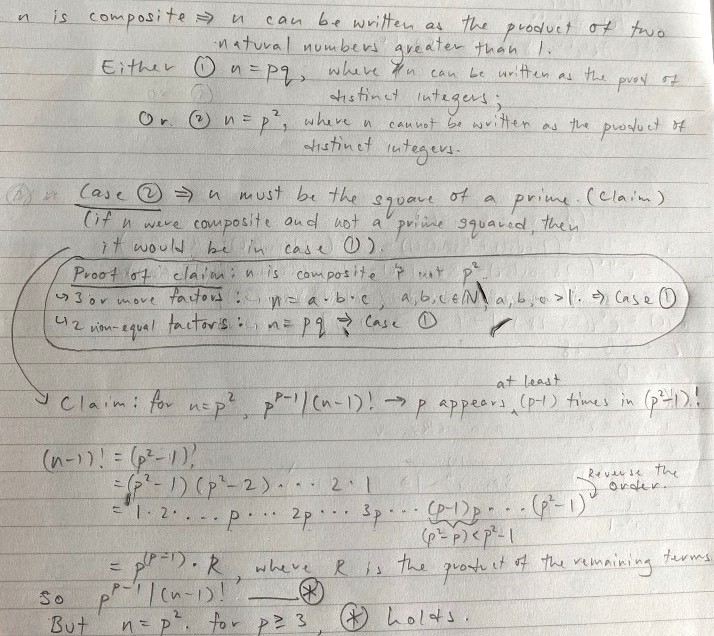Ask Singapore Homework?
Upload a photo of a Singapore homework and someone will email you the solution for free.

Question
junior college 2 | H2 Maths
3 Answers Below
Anyone can contribute an answer, even non-tutors.

Pls send help my brain is dying
Btw I came up with one of the cases : p and q are distinct and both less than n.
Hence pq|(n-1)!
Need help with the other caseeee
Ps this is a H3 qn I posted it as H2 so more people can see :D
x = 2k + 1 , k ∈ Z (set of integers)
y = 2n + 1, n ∈ Z
x² = (2k + 1)² = 4k² + 4k + 1
y² = (2n + 1)² = 4n² + 4n + 1
When k = n,
x² + y²
= 2(4k² + 4k + 1)
= 2(2k + 1)²
If x² + y² is a perfect square, then it could be written in the form w² where w ∈ Z
Then 2(2k + 1)² = (√2(2k + 1))²
2k + 1 is an integer but √2 is irrational so √2(2k + 1) is irrational.
Which means that it cannot be written in the form w² where w ∈ Z, so it cannot be a perfect square.
x² + y²
= (2k + 1)² + (2n + 1)²
= 4k² + 4k + 1 + 4n² + 4n + 1
= 4(k² + k + n² + n) + 2
If we divide (x² + y²) by 4, it leaves a remainder of 2.
However for perfect square numbers,
Odd square numbers are in the form (2m + 1)²
= 4m² + 4m + 1
= 4(m² + m) + 1, where m ∈ Z
Even square numbers are in the form (2m)²
= 4m²
The former leaves a remainder of 1 when divided by 4 but the latter leaves no remainder.
So x² + y² doesn't belong to either case and so is not a perfect square
If n is a composite positive integer, then n ∣ (n - 1)!
Cases :
① n = ab where both a and b are composite themselves
a,b ∈ Z+
a,b < n
a < b
Since (n - 1)! = (n - 1)(n - 2)(n - 3)....(b)...(a)....(1),
Then (n - 1)! is a multiple of ab and so ab ( = n) divides (n - 1!)
n = c² , where c is composite, c < n
but since c is composite, then c can be rewritten as the product of prime factors.
Which means c² can be rewritten into the form ab → back to case ①
Case ③
n = d², where d is prime and d < n
(n - 1)!
= (n - 1)(n - 2)...(n - d)...(d)...(1)
(Since d < n means n - d > 0, so n - d is one of the factors of (n - 1)!)
= (d² - 1)(d² - 2)...(d² - d)...(d)...(1)
= (d² - 1)(d² - 2)...(d)(d - 1)...(d)...(1)
= (d² - 1)(d² - 2)...(d²)(d - 1)...(1)
So (n - 1)! is always a multiple of d², which means that n divides (n - 1)!
HOWEVER,
This is provided that d² - d > d.
Eg. If d = 3, then 3² - 3 = 6 > 3
d² - d > d
d² - 2d > 0
d(d - 2) > 0
d > 0 or d > 2 → overall d > 2
(We already know that d cannot be 1 so no need to consider)
So the exception is when d = 2
n - d = d² - d = 2² - 2 = 4 - 2 = 2
This means that there will only be 1 factor d and not two distinct factors d and d² - d)
i.e
When d = 2, n = 2² = 4
(n - 1)! = 3 x 2 x 1
There is only one '2' in the product. So not divisible by 2²
But when d = 3, n = 9
(n - 1)!
= 8!
= 8 × 7 × (3² - 3) × ... × 3 × 2 × 1
= 8 × 7 × (3 × 2) × ... 3 × 2 × 1
There are two '3's so definitely divisible by 9
See 3 Answers
For case (a), we can show that p^(p-1) divides (n-1)!. This implies p^2 divides (n-1)!, for p greater than or equal to 3.
The proof in the photo was before I streamlined the argument, so I suggest you follow the above proof.
Hope this helps :)






